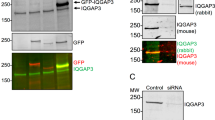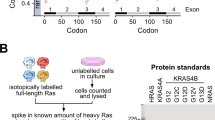Abstract
Members of the Ras subfamily of GTP-binding proteins, including Ras (H-, K-, and N-), TC21, and R-ras have been shown to display transforming activity, and activating lesions have been detected in human tumors. We have identified an additional member of the Ras gene family which shows significant sequence similarity to the human TC21 gene. This novel human ras-related gene, R-ras3, encodes for a protein of 209 amino acids, and shows ∼60 – 75% sequence identity in the N-terminal catalytic domain with members of the Ras subfamily of GTP-binding proteins. An activating mutation corresponding to the leucine 61 oncogenic lesion of the ras oncogenes when introduced into R-ras3, activates its transforming potential. R-ras3 weakly stimulates the mitogen-activated protein kinase (MAPK) activity, but this effect is greatly potentiated by the co-expression of c-raf-1. By the yeast two-hybrid system, R-ras3 interacts only weakly with known Ras effectors, such as Raf and RalGDS, but not with RglII. In addition, R-ras3 displays modest stimulatory effects on trans-activation from different nuclear response elements which bind transcription factors, such as SRF, ETS/TCF, Jun/Fos, and NF-κB/Rel. Interestingly, Northern blot analysis of total RNA isolated from various tissues revealed that the 3.8 kilobasepair (kb) transcript of R-ras3 is highly restricted to the brain and heart. The close evolutionary conservation between R-ras3 and Ras family members, in contrast to the significant differences in its biological activities and the pattern of tissue expression, raise the possibility that R-ras3 may control novel cellular functions previously not described for other GTP-binding proteins.
This is a preview of subscription content, access via your institution
Access options
Subscribe to this journal
Receive 50 print issues and online access
$259.00 per year
only $5.18 per issue
Buy this article
- Purchase on Springer Link
- Instant access to full article PDF
Prices may be subject to local taxes which are calculated during checkout
Similar content being viewed by others
Author information
Authors and Affiliations
Rights and permissions
About this article
Cite this article
Kimmelman, A., Tolkacheva, T., Lorenzi, M. et al. Identification and characterization of R-ras3: a novel member of the RAS gene family with a non-ubiquitous pattern of tissue distribution. Oncogene 15, 2675–2685 (1997). https://doi.org/10.1038/sj.onc.1201674
Received:
Revised:
Accepted:
Issue Date:
DOI: https://doi.org/10.1038/sj.onc.1201674
Keywords
This article is cited by
-
R-Ras subfamily proteins elicit distinct physiologic effects and phosphoproteome alterations in neurofibromin-null MPNST cells
Cell Communication and Signaling (2021)
-
New susceptibility locus for obesity and dyslipidaemia on chromosome 3q22.3
Human Genomics (2013)
-
Mutations in PIK3CAare infrequent in neuroblastoma
BMC Cancer (2006)
-
Expression of activated M-Ras in hemopoietic stem cells initiates leukemogenic transformation, immortalization and preferential generation of mast cells
Oncogene (2006)
-
Expression of a constitutively active mutant of M-Ras in normal bone marrow is sufficient for induction of a malignant mastocytosis/mast cell leukemia, distinct from the histiocytosis/monocytic leukemia induced by expression of activated H-Ras
Oncogene (2005)



